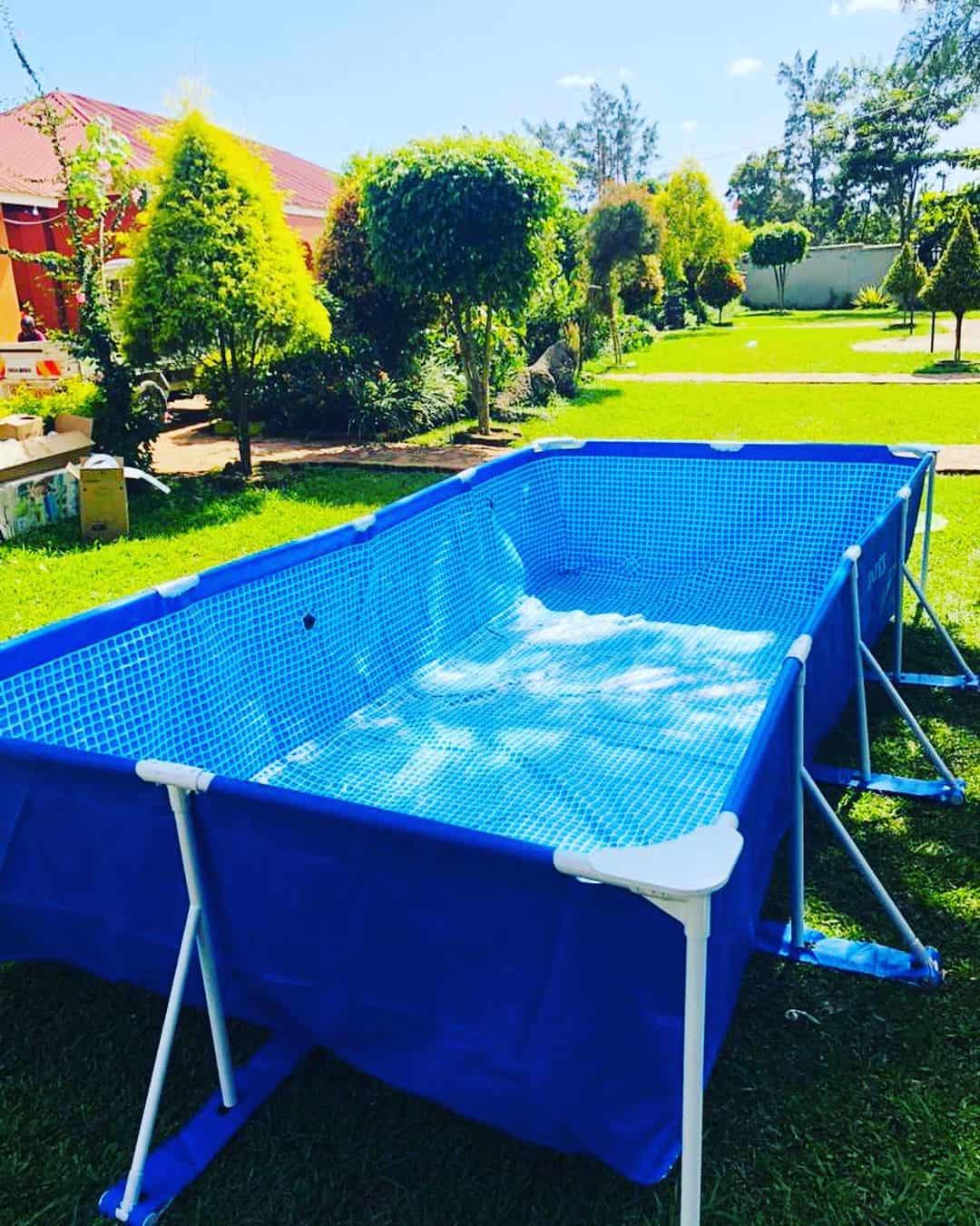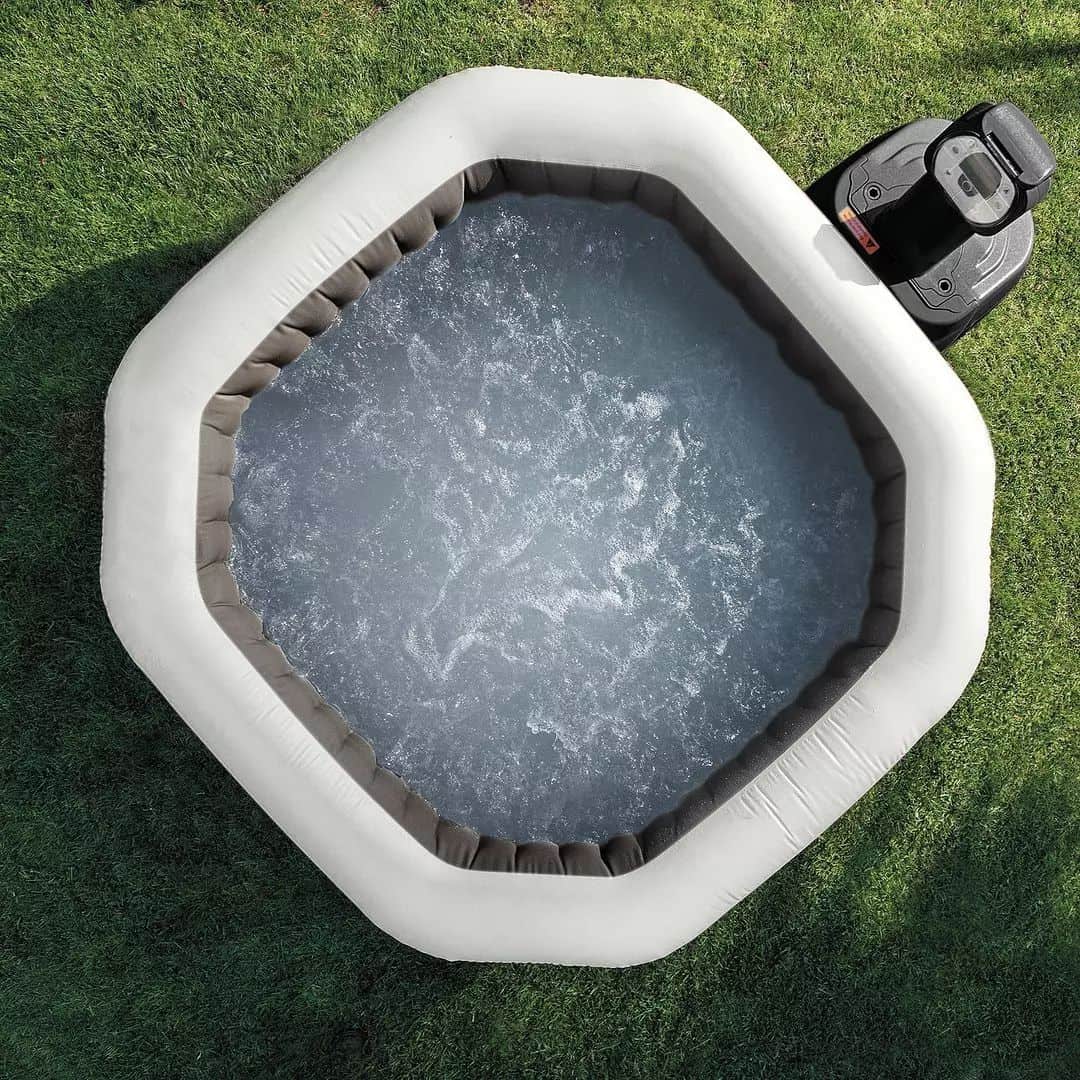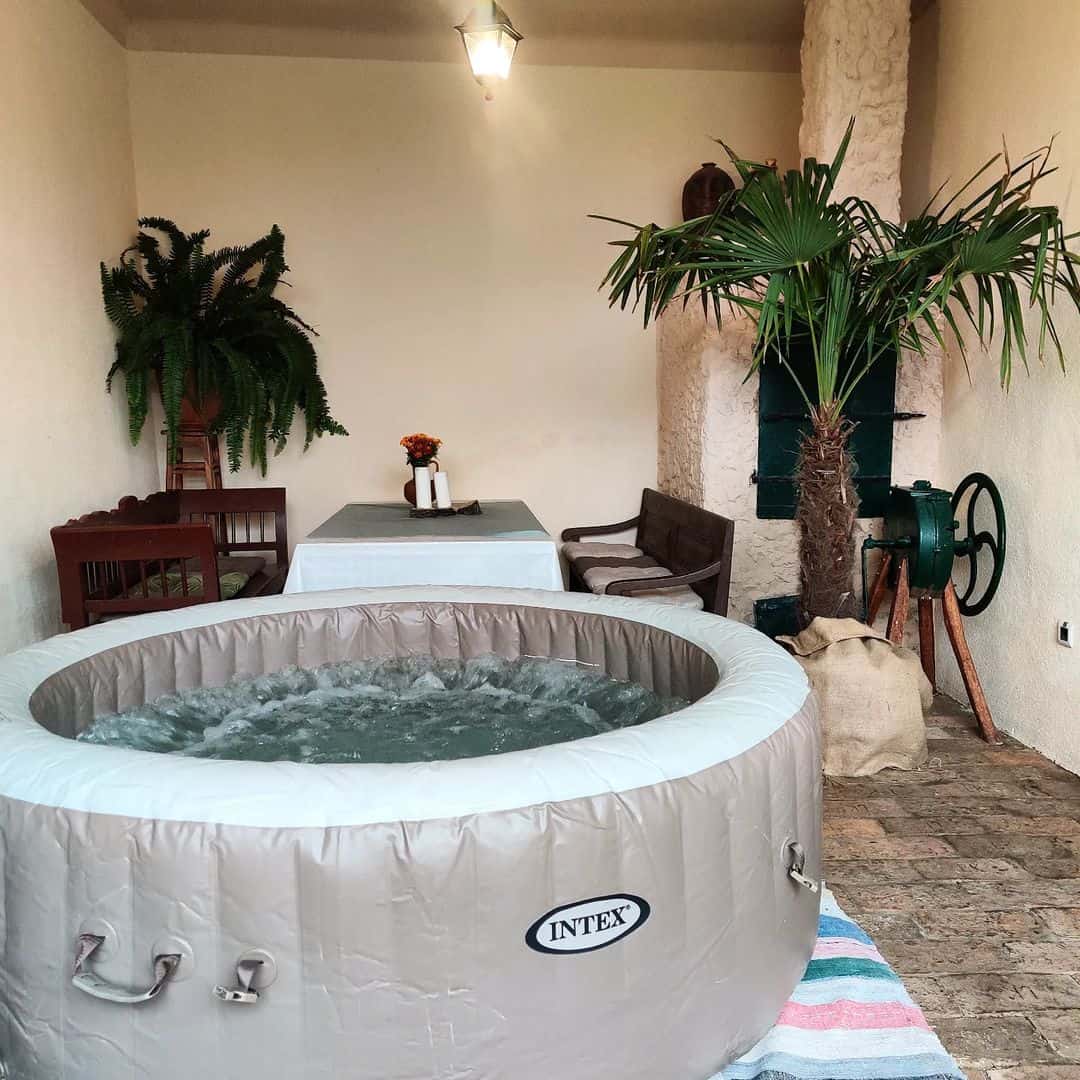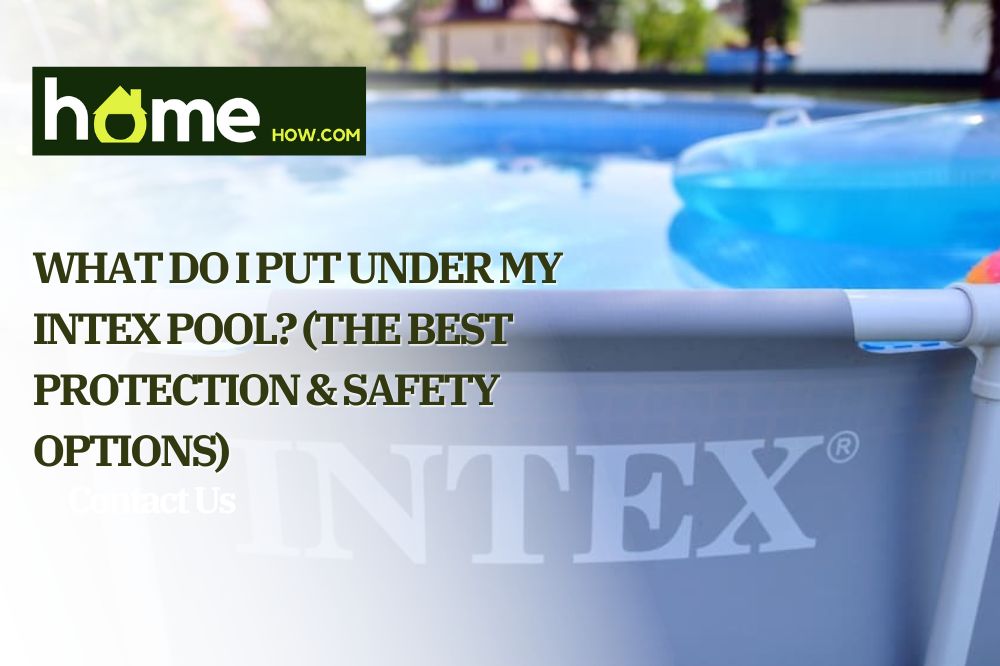Have you recently purchased an Intex pool? But before you install it, let’s first address this question: “What do I put under my Intex pool?”
Without this layer, sharp objects can easily damage the vinyl liner. You don’t want this to happen, of course!
So if you want your above-ground pool to last longer, make sure to follow the recommendations below.
What Should You Put Under the Bottom of the Pool?
Intex pool owners can place any of the following products underneath:
1. Intex Ground Cloth
Intex Easy Set or Frame Pools often come with a complementary ground cloth. They’re available in various sizes, which can fit the following pool dimensions:
- 8 feet
- 10 feet
- 12 feet
- 15 feet
This above-ground pool liner is cheaper than most, and you can install it relatively quickly. And although it offers some degree of protection, its thin composition makes it inferior compared to the other items in this list.
2. Pool Floor Pad
As the name suggests, this mat can be placed under the swimming pool to avoid punctures and whatnot.
As it is often thicker than the Intex Ground cloth, it can provide an added layer of protection for your pool bottom. However, this feature makes it more expensive than the said ground cloth. Prices start at $200, whereas you can get the ground cloth for only $18.
However, if you end up damaging your Intex pool because you went with a cheaper liner, you’ll end up paying a lot for repairs/replacement as well.
Should you go for a pool pad, make sure to follow the size of your pool. Avoid buying a bigger one, for you might end up cutting the excess in the long run. Some people may end up tripping on this layer, after all.

3. Padding
You can also place padding under your Intex pool. And depending on your needs/budget, you can choose from any of these two:
- Floor underlayment – Made of a spongy, flexible foam sheet
- Carpet padding – Used for carpets; thicker than floor underlayment
While both options are cheap (costing $100 upwards) and easy to cut, you’ll need several layers to protect your pool from punctures. Likewise, you’ll need some to save your feet from that uncomfortable feeling.
4. Foam Tiles
Solid foam tiles are the best products you could put underneath your Intex or paddling pool liner.
Compared to the other items in this list, they provide a great deal of floor padding. You don’t have to contend with irregular surfaces, which could bother you and other users.
Another great thing about foam padding is they make pool cleaning hassle-free. After all, it’s easier to vacuum a pool that doesn’t have dips/indentations at the bottom.
Pre-cut foam sheet tiles are available in 3/8-inch thick, 2×2-foot sizes. This means you’re going to need the following:
- 35 tiles for a 10-foot pool (140 sq. ft.)
- 60 tiles for a 15-foot pool (240 sq. ft.)
- 80 tiles for an 18-foot pool (320 sq. ft.)
- 115 tiles for a 20-foot pool (460 sq. ft.)
- 145 tiles for a 24-foot pool (580 sq. ft.)
While foam tiles offer many benefits, they aren’t as breathable as the other products on this list. They’re also quite expensive – starting at $17 per tile – but you get what you pay for!
Should you go with the cheaper ones, don’t be surprised if they get deformed earlier than expected.
As long as you properly care for your foam tiles, you can expect them to last a decade (or more.) This is especially true if you purchase products made from extremely tough materials.

5. Concrete Slabs
If you’re planning on putting your pool on a leveled surface, consider placing concrete slabs underneath it. They cost about $6.60 per sq. ft. They make for perfect pool foundations, mainly because they also deliver pool leg support.
Since concrete can get abrasive, you’ll need to put another layer on top. This may cost you some money – unless you use the free options in this list (i.e., old carpet or tarp.)
6. Old Carpet
If you don’t want to spend some money – and have an old carpet lying around – you’ll be glad to know that you can use it to cushion the bottom of your pool.
And yes, you can also put it underneath your kid’s paddling pool.
As you would do so in your home, you only have to place it plush side up.
Carpets are breathable and can easily protect your pool from gravel, rocks, and other sharp objects. They can help retain heat too!
But compared to foam tiles, they provide little cushioning. They’re harder to cut, too, especially since most carpets are made from sturdy materials.
Even so, carpets that frequently get wet will only last for one-two seasons tops.
7. Tarp
Another free (or inexpensive) workable option is a tarp. It’s made from polyethylene, which is a sturdy yet waterproof material.
Like a ground cloth, it can protect your pool bottom – albeit minimally.
Tarps are best used on inflatable, Summer Ways, and Best Ways pools.

Should You Put Sand Under Your Intex Pool?
No.
While it is tempting to use sand – being that it’s cheap and easy to add – you shouldn’t. Whether it’s regular sand or the finer mason sand, they mustn’t be used for pool lining.
For one, it could easily be washed down by rain. It couldn’t protect your pool from insects and bugs as well.
And even if these don’t affect your pool, it could end up shifting in the end. You may also feel dips underneath, especially in the areas with high foot traffic.
Why Should You Put a Layer Underneath Your Intex Pool?
As mentioned above, a pool layer can help protect your inflatable pool from damage. But apart from that, it can also:
- Provide a more comfortable walking surface
- Prevent mold and mildew growth
- Prevent grass and insect-caused damage
- Make cleaning easier
Where Should You Place an Intex Pool?
According to Intex, their pools should be placed on flat, hard, and leveled surfaces devoid of sharp objects.
Following this recommendation, the best place to put an Intex pool is on top of concrete surfaces. That makes patios or driveways good candidates. After all, these areas are sturdy and relatively flat.
But before pool installation, it’s best to clear the area. Again, gravel and rocks may end up puncturing your pool. Concrete is not that comfy to walk on either, which is why it’s good to put a padded layer underneath.
You can also place your pool on top of the grass, but you need to keep these reminders in mind:
- The grass shouldn’t be hardy or aggressive
- The pool shouldn’t go on top of Bermuda or St. Augustine grass
Granted that your grass doesn’t belong to the said categories, you still have to kill the weeds first. If not, they may end up penetrating and destroying your pool.
And since grass is a soft layer, it’s best to use a sturdier layer underneath. Again, foam tiles should do the trick.
Tip: If you plan on putting Intex pools with metal feet on top of the grass, make sure to support them with wood, clay bricks, or concrete pavers.
How to Maintain Intex Pools
If you want your Intex pool to last longer, you’ll need to follow the maintenance tips from this informative video :
1. Balance Your Water Chemistry
Since Intex pools hold less water, they’re more prone to chemical imbalances. As such, you’ll need to check and balance your pool regularly – especially during times of frequent use.
The same thought applies during the rainy season – or if there is plenty of debris floating in your pool.
According to experts, it’s best to test your water once a week. As for balancing your pool water, you’ll need to have the following at hand:
- Alkalinity increaser
- pH increaser and decreaser
- Chlorine granules/pucks
- Cyanuric acid (stabilizer)
- Non-chlorine shock
2. Ensure Good Circulation
Without a good-functioning pump, your pool chemicals won’t work as well as they should. That’s why you need to run your pump at least 8 hours a day.
As for your return jets, they should be placed at a 45-degree angle (towards the pool bottom.) This will improve circulation – thus avoiding dead zones where algae commonly grow.
3. Follow a Cleaning Routine
Regularly cleaning your pool will help prevent debris build-up, clogging, and whatnot. And to do so, you’ll need to have the following items on hand:
- Skimmer net – use every other day
- Pool vacuum – use once a week
- Nylon brush – use every other day, especially during high season
Conclusion
Your Intex pool bottom can get easily punctured, which is why you need to put a layer underneath it. The best options are foam tiles, though you may also use the following:
- Intex ground cloth
- Pool floor pad
- Padding
- Concrete slabs
- Old carpet
- Tarp
Avoid using sand, for it may get washed down by rain immediately!
Have you used any of the Intex pool layers mentioned above? Which is the best choice? Share your thoughts below!
